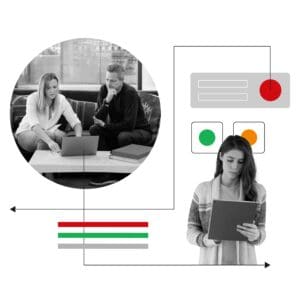
Table of Contents
In the competitive landscape of SME device and equipment manufacturing, even small improvements in efficiency can have enormous impacts.
Smaller-scale manufacturers tend to avoid the ‘digital transformation’ conversation, hoping to keep their processes simple. However, as your business grows, implementing a system that can not only create efficiencies in production but can improve your entire business becomes essential.
There is nothing worse than trying to digitally transform your business while trying to grow your team, meet the demands of an important new customer and improve the quality of your outputs.
Cloud-based Material Requirements Planning (MRP) software offers a comprehensive solution for business owners hoping to streamline operations, manage inventory, and increase efficiency in their production processes.
In this guide, we’ll delve into the world of cloud-based MRP software, focussing particularly on the issues encountered by smaller-scale manufacturers in the UK, uncovering the key benefits of MRP systems, tips for successful implementation processes, and real-life success stories.
Introduction
Small manufacturers face a unique set of challenges, ranging from inventory management issues to complex production planning with small, highly specialised teams.
Traditional manufacturing methods often fall short of addressing these challenges efficiently, often duplicating work, inaccurately representing inventory levels and eventually slowing down production. SME manufacturers sometimes think that because they have a small production team, they can manage their entire business with hard copy checklists and a few shared spreadsheets.
However, even in small teams, inefficiencies arise when your sales team aren’t communicating with your production team, who aren’t effectively communicating with the purchasing manager, who hasn’t cleared budgets with the finance director, who is too busy pulling together a monthly report for the board to approve an essential supplier invoice!
Enter Cloud-Based MRP software – a technology designed to transform manufacturing processes for the better by pulling your entire business into one platform. MRP systems aren’t just for the manufacturing part of your business, they ensure your whole business is pulling together.
Understanding Cloud-Based MRP Software
MRP software is a digital solution that allows manufacturers to manage their material requirements, production scheduling, and inventory levels in real-time. This software leverages the power of cloud computing, providing businesses with the ability to access data from anywhere, collaborate seamlessly, and scale efficiently.
For example, Flowlens provides a full suite of production and inventory management tools but also provides a simple CRM, an optional after-sales servicing module and integrates with accounting packages such as Xero and Quickbooks to provide a complete end-to-end manufacturing software solution.
Unlike traditional MRP software, cloud-based systems are always on, always secure and always available on any device – giving you ultimate peace of mind in running your company.
For small businesses, the adoption of cloud-based MRP software brings a range of benefits. From the ability to spread the cost over a longer period (most cloud-based MRP systems are subscription-based), to the option to only pay for functionality you need for your business stage, these advantages are tailored to address the specific needs of small-scale manufacturers.
The Role of MRP Systems in Production Optimisation
Demand Forecasting and Inventory Planning
Accurate demand forecasting is crucial for efficient production planning. Cloud-based MRP systems offer tools that aid in estimating demand based on live stock information and an understanding of what materials have been assigned to new orders and even estimating quantities required to meet the demand of upcoming orders.
By providing real-time insights, manufacturers can align production with customer needs to ensure they never halt production due to stock shortages.
Enhancing Collaboration and Communication
Multi-Departmental Coordination
The collaborative nature of cloud-based MRP systems breaks down silos within an organisation, creating a ‘single version of the truth’. Various departments can access real-time data, enabling informed decision-making and smoother coordination and helping personnel get a better understanding of work that happens outside of their day-to-day task list. In our experience, this is often the ‘breakthrough moment’ for many shopfloor team members as they can easily visualise bottlenecks and stoppages in workflow.
Supplier and Customer Integration
MRP software goes beyond internal collaboration; it fosters better communication with suppliers and customers. Enhanced order tracking, lead time management, and supply chain visibility result in improved relationships and streamlined operations.
Flowlens’ simple CRM function allows you to automate deadline reminders and follow-up tasks to ensure you’re keeping in touch with your buyers on time. With our optional aftersales module you can track service jobs to increase your customer retention and generate valuable new revenue streams.
Steps to Implement Cloud-Based MRP Software
Evaluating Your Business Needs
Choosing the right MRP system requires understanding your business requirements. Identify pain points and goals to ensure a suitable solution can be identified that fits with your business processes, budgets and aspirations.
Process Mapping for Manufacturers
As Anglea Fumpson says in Episode 4 of our manufacturing podcast, Made To Grow, a full understanding of your current process is essential for successfully implementing any new MRP system.
Often our business processes have never been fully planned they “just happen,” at other times they change and become more complex as our business grows. Either way, it is essential to understand how your process works and how it connects across everyone’s workflow to better solve the issues you’re currently facing.
“I always start with the customer journey, from an early enquiry right through to a paid, happy customer at the end, and we walk the journey step-by-step.”
Angela Fumpson
Choose Your Champion
For any successful implementation of an MRP system or any other manufacturing software, making one person responsible for its success is an important step. Making this one person’s mission and giving them the authority, the time and the resources to successfully manage this will ensure you have a passionate advocate for change in the company. Ensure this person is someone who can inspire and persuade, rather than someone with a “top-down” approach to change.
Open Communication
Make sure to leave space in your plan to share the findings of your research, hear feedback, incorporate and address that feedback and make people at all levels of your business part of the change. Identify and actively engage with anybody who might be resistant to the incoming system. Try to work out their objections and show how the change will benefit them.
“If you involve everyone in the process and they can clearly see what’s in it for them and how it can benefit their way of working – then you’ll get buy-in. “
Angela Fumpson
Standardising Tasks and Increasing Staff Efficiency
Streamlined Workflows
Cloud-based MRP systems help to create standardised workflows for different manufacturing stages, including planning jobs and purchasing, managing work and stock; and spotting problems early on. This streamlining reduces errors and improves consistency.
To-Do Lists and Task Prioritisation
Simplified to-do lists generated by the MRP system help employees manage tasks efficiently. Prioritisation and automated reminders ensure important tasks such as sales follow-ups, packaging requirements or quality assurance tasks are never overlooked.
Multi-Skilling Opportunities
Simplified task management and shareable workflows encourage employees to take on broader roles. Cloud-based MRP systems promote multi-skilling and cross-functional training. For instance, creating an interactive to-do list (with our custom forms add-on) allows shopfloor staff to follow simple steps in tasks such as quality assurance, packing and despatch.
Performance Measurement and Continuous Improvement
MRP software tracks task completion and performance metrics allowing management to get a high-level view of production and identify bottlenecks and blockages in the manufacturing process in real time. Reviewing this information with your team can help identify training needs and opportunities for improvement.
Interested in learning more about Continuous Improvement? We recently interviewed Lean Manufacturing guru, Tom Hughes on the Made To Grow podcast – click here to watch the full interview!
Conclusion
Cloud-based MRP software represents a transformative solution for small manufacturers. By optimising production processes, improving collaboration, and standardising tasks, businesses can achieve heightened efficiency and growth. Embracing cloud-based MRP software is more than an investment—it’s a strategic move towards mastering manufacturing in the modern age.
Where are you on your digital transformation journey?
Take our five-minute self-assessment quiz to see your ‘digital readiness’ score.





